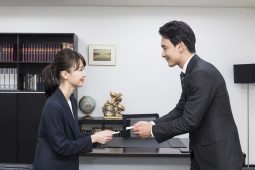When trying to picture a Japanese city like Tokyo and its inhabitants, one of the first things that comes to mind is a crowd of straight-backed people with stern faces. The cliché of office workers exclusively wearing suits is no myth. The dress code in Japanese businesses is commonly rigid and almost as standard as school uniforms. For a start, colours are rather dark as workers would mostly wear black, dark blue or grey. You would never see a “salarywoman” wearing a summer dress to go the office for instance. Even when short-sleeves are tolerated, tank tops that reveal the entire arm are not considered appropriate and as a minimum, the shoulders and the upper part of the arms should be covered. When it comes to bottoms, if they are not wearing dark trousers Japanese women will wear skirts which will, however, reach at least until below the knees. I was also surprised to hear that peep toe shoes were not tolerated either. Those can be considered very formal or dressed-up in the West as many female office workers wear them along with a suit, but they are a no-go in Japan. That was actually one of the first thing I was told before starting my first job.
Although not exactly directly related to dress code, but nevertheless another point for women to keep in mind when they are about to start working in Japan is the wear of perfume. I quickly learned that Japanese people were very sensitive to strong smells, even perfume. Therefore, foreign workers often have to switch to milder scents in order to accommodate their colleagues.
The only exception to the strict Japanese dress code would be during the well-known “Cool Biz” and less popular “Warm Biz” seasons. Even though those are English terms, foreigners do not understand them until they move to Japan and hear them in context. Basically, in order to decrease the consumption of energy through air-conditioning and heating during the hottest and coldest months of the year, Japan encourages more casual outfits. This is why you will see in the summer many Japanese men for instance wearing short-sleeved shirts, no tie and no jacket. Following the same logic but not as common, in the winter office workers are allowed to wear a jumper on top of their shirt and underneath their jackets so that employees would not need to adjust the temperature in the office which would affect not only the company’s bills but also global warming.
The level of formality used to address different colleagues is even more challenging to get your head around. Indeed, based on different factors Japanese people will use different degrees of keigo. There is of course the sempai – kohai relationship that will determine how to address someone. Sempai refers to someone who is at a higher level in the hierarchy. This can be determined by a person’s age, whether they have joined the company before you, or simply their job title. Whereas kohai refers to people at a lower rank, younger, or someone who has joined the company after you. Finding out someone’s age is important whereas in Western countries it might sound like an offensive question.

The sempai — kohai relationships are not specific to the workplace as they are also used in the school system for instance. The higher level of keigo is also very challenging to master for Japanese people. If keigo seems extremely difficult for foreigners to learn, many Japanese workers admit that they find the higher degrees of keigo very challenging to use. Indeed, they will be addressing people differently depending on how high their interlocutor stands in the hierarchy. The way they will speak to a sempai will also different from how they treat their manager and even the CEO of the company who will get the highest level of politeness possible.
Finally, although Tokyoites can be very formal in the capital, it is said that people in other parts of Japan could be a little more casual even in the workplace when communicating. Indeed, in other regions, people are more laid-back when it comes to formality. As an illustration, in Kansai the locals might use “tameguchi” which is a very casual way of addressing someone.








